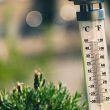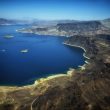Grid operators in western states brace for another prolonged heat wave
In the middle of an exceptionally hot summer, western grid operators are bracing for another potentially record breaking heat wave that could be the season’s most punishing yet.
“In what’s likely to be the most extensive heat wave in the West so far this year, temperatures in Northern California are expected to be 10-20 degrees warmer than normal through Tuesday, Sept. 6,” reads an advisory issued Tuesday by the California Independent System Operator (CAISO). “In Southern California, temperatures are expected to be 10-18 degrees warmer than normal.”
The impending heat is expected to strain the grid as everyone seeks cool shade and air conditioning during an already busy holiday weekend. With temperatures cresting triple digits in some areas, peak load is expected to exceed 48,000 megawatts on Monday—the highest usage so far this year. And the increase comes as climate change is simultaneously impacting the Pacific Northwest’s ability to generate hydropower.
“Energy reliability becomes more challenging; energy reliability becomes more stressed because demand increases at the same time as supply decreases,” said Calif. Gov. Gavin Newsom in a briefing Wednesday ahead of the predicted heat wave. “For years, and years and years, we, all of us, have been trying to outrun Mother Nature. But it’s pretty clear that Mother Nature has outrun us. The reality is that we’re living in a state of extremes: Extreme drought, extreme heat.”
At its height, Newsom said temperatures are projected to reach 122 degrees in Death Valley. And elsewhere, residents are facing “A prolonged heat moment,” he continued, to “a length and duration the likes of which we haven’t seen in some time.”
Ahead of the forecast, California’s grid operators called for reduced energy usage during the day, when the system is most stressed, and pre-cooling measures during non-peak hours. Maintenance restrictions have also been issued.
Newsom also signed an executive order allowing administrators to create flexibility by actions like diversifying energy sources and keeping ships out at sea operating under their own power.
For many in the state, it’s a familiar experience. In 2020, utility operators implemented rotating outages during another exceptional heatwave that challenged systems. And looking into the future, it’s clear that extreme heat is here to stay.
In a study, researchers from North Carolina State University considered 11 different climate scenarios between 2030 and 2060, drawing on scientific climate change models calculated to simulate a worst-case scenario and another, less severe scenario.
They concluded that “the impacts of climate change and extreme weather events on the grid, mostly in the form of drought and heat waves, are going to get worse under climate change,” said Jordan Kern, assistant professor of forestry and environment resources at North Carolina State. “As it gets hotter and hotter and hotter, and demand for electricity gets higher, we expect the grid to fail.”
The findings were published via two studies in the journal Earth’s Future. The repurcussions of this evolving reality extend beyond California. Because of the modern grid’s interconnectedness, the ripple effect of a blackout in one regional system could spill over and impact others elsewhere, according to the research.
The “West Coast power system is strongly influenced by variability and extremes in air temperatures (which drive electricity demand) and streamflows (which control hydropower availability),” reads the abstract of one of the two studies, “The Effects of Climate Change on Interregional Electricity Market Dynamics on the U.S. West Coast.” As the climate continues to change, “a combination of forces may work in tandem to make its bulk power system more vulnerable to physical reliability issues and market price shocks.”




















